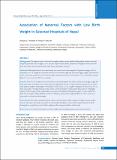Please use this identifier to cite or link to this item:
https://hdl.handle.net/20.500.14356/1748Full metadata record
| DC Field | Value | Language |
|---|---|---|
| dc.contributor.author | Shakya, K L | - |
| dc.contributor.author | Shrestha, N | - |
| dc.contributor.author | Kisiju, P | - |
| dc.contributor.author | Onta, S R | - |
| dc.date.accessioned | 2023-05-21T07:02:24Z | - |
| dc.date.available | 2023-05-21T07:02:24Z | - |
| dc.date.issued | 2015 | - |
| dc.identifier.citation | ShakyaK. L., ShresthaN., KisijuP., & OntaS. R. (2015). Association of Maternal Factors with Low Birth Weight in Selected Hospitals of Nepal. Journal of Nepal Health Research Council. https://doi.org/10.33314/jnhrc.v0i0.635 | en_US |
| dc.identifier.issn | Print ISSN: 1727-5482; Online ISSN: 1999-6217 | - |
| dc.identifier.uri | http://103.69.126.140:8080/handle/20.500.14356/1748 | - |
| dc.description | Original Article | en_US |
| dc.description.abstract | Abstract Background: The high prevalence of low birth weight remains a major public health problem around the world. Nepal has prevalence of it as high as 21%. Because of poor dietary intake, majorities of Nepalese women have low body mass index and are anaemic that results in poor pregnancy outcome. Methods: This hospital based case-control study was carried out in four hospitals of Nepal from August 2012 to September 2013. It sought the association of factors to low birth weight like maternal height, weight, and body mass index, food intake, past history of low birth weight, and preterm delivery. Total sample of 1533 were taken, among them 511 were cases and 1022 were controls. Results: Total of 1533 mothers were interviewed across four hospitals. The study revealed mean height, weight and body mass index of mothers were 150cm (SD:6.6), 49kg (SD:6.8), and 21.5kg/m (SD:3) respectively. On crude odds analysis, mothers with height <145cm had 1.5 times (CI:1.1-2.1), weight <45kg had 2.4 times (CI:1.9-3.1), body mass index <18.5kg/m2 had 2.2 times (CI:1.6-2.9), food taken <2 times had 2 times (CI:1.4-2.9) higher chance of delivering low birth weight babies respectively. On adjusted OR analysis, height <145cm (AOR=0.5, CI:0.3-0.9); weight <45kg (AOR=0.5, CI:0.3-1.0) history of low birth weight (AOR=5.1, CI:2.1-12.8) were associated to current low birth weight. Conclusions: The study concluded that the chances of delivering low birth weight were higher among mothers who are thin, short, low body mass index, less food intake, had history on low birth weight and preterm birth. Among them, a past history on low birth weight was the strongest predictor in this study. Keywords: case control; food intake; low birth weight; maternal anthropometry; past obstetric history | en_US |
| dc.language.iso | en | en_US |
| dc.publisher | Nepal Health Research Council | en_US |
| dc.relation.ispartofseries | May-Aug, 2015;635 | - |
| dc.subject | Case control | en_US |
| dc.subject | Food intake | en_US |
| dc.subject | Low birth weight | en_US |
| dc.subject | Maternal anthropometry | en_US |
| dc.subject | Past obstetric history | en_US |
| dc.title | Association of Maternal Factors with Low Birth Weight in Selected Hospitals of Nepal | en_US |
| dc.type | Journal Article | en_US |
| local.journal.category | Original Article | - |
| Appears in Collections: | Vol. 13 No. 2 Issue 30 May - August 2015 | |
Files in This Item:
| File | Description | Size | Format | |
|---|---|---|---|---|
| 635-Article Text-1171-1-10-20151231.pdf | Fulltext Download | 217.82 kB | Adobe PDF |  View/Open |
Items in DSpace are protected by copyright, with all rights reserved, unless otherwise indicated.
